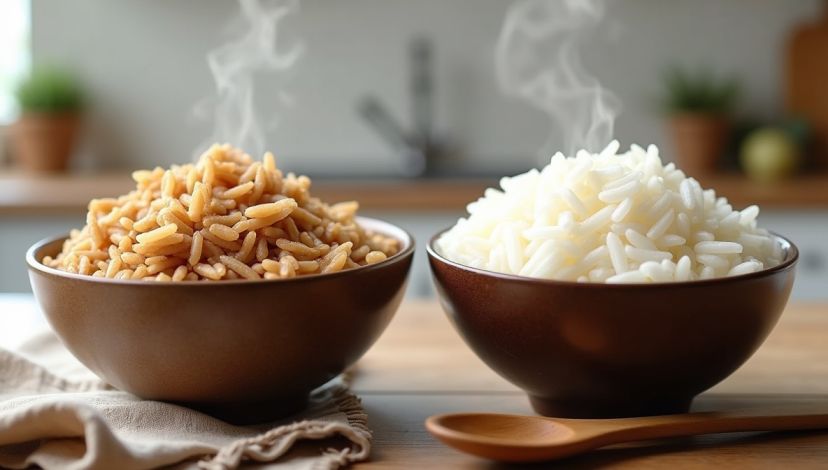Brown Rice vs White Rice: Nutritional Benefits Compared

When it comes to choosing between brown rice vs white rice, many people wonder which one is better for their health. Both these rices are stapled in the diets of the whole world, however, they vary in its treatment, nutrition and body responses. Brown rice is a complete grain, which is not de-branned and de-germed whereas white rice is milled and retains very little of the bran and the germ, primarily the starchy endosperm. This variation has an effect on their content of fiber, vitamins, minerals and digestion. Such differences can alert you to make the right decisions on the type of rice to be taken in your diet.
Table of Contents
- What Is The Differences Between White Rice And Brown Rice?
- What is The Difference Between Brown Rice and White Rice?
- What is The Health Value of Brown Rice against White Rice?
- What would be the Influence of The Glycemic Index on Brown Rice and White Rice?
- Which Is Better Rice To Use To Manage Their Weight And Be Healthy?
- Conclusion
- FAQ’s
Key Points:
- Brown rice has fiber and higher nutrients than white rice.
- It has smaller quantities of fiber that is easy to digest and takes a shorter time to cook white rice.
- The decision on the choice of one of them is forced by your health needs and preferences.
What Is The Differences Between White Rice And Brown Rice?
The main distinction between brown rice and white rice consists in their processing. Brown rice is a whole grain, which implies that it contains all three components of the grain, the bran, the germ and the endosperm. This makes it tan and with a nuttier flavor. The bran and germ are removed in the milling process of white rice which results in a softer and faster-cooking rice but also in a less nutrient food.
The bran and germ parts of brown rice are rich in fiber and vitamins such as B1, B3 or B6 and minerals such as magnesium and potassium. These ingredients have health value such as easy digestibility and reduce rate of energy dispersal. White rice has subsequently had these layers removed, and as a result have fewer nutrients naturally contained in the rice, being usually artificially enriched with a piece of the best vitamins and minerals.
Brown rice is also slow to digest and thus keeps the blood sugar levels stable because of fiber content. White rice is less fibrous thereby digests faster and can likely result in a faster start in blood sugar. Such disparity can be relevant with individuals dealing with diabetes or blood sugar problems.
Tip: When you experience digestive problems such as irritable bowel syndrome it may be more comfortable to consume white rice since it contains less fiber.
What is The Difference Between Brown Rice and White Rice?
Brown rice tends to beat white rice in nutrition especially when it comes to fiber, vitamins as well as minerals. A comparison of nutrients given is as follows per 1/3 cup cooked:
| Nutrient | Brown Rice | White Rice |
|---|---|---|
| Calories | 82 | 68 |
| Protein | 1.83 g | 1.42 g |
| Total Fat | 0.65 g | 0.15 g |
| Carbohydrates | 17.05 g | 14.84 g |
| Fiber | 1.1 g | 0.2 g |
| Magnesium | Higher content | Lower content |
| Iron | 0.37 mg | 0.63 mg* |
| B Vitamins (B1, B3, B6, B9) | Present in good amounts | Often added back by enrichment |
*Note: White rice may be fortified with iron and a little B vitamins during processing, but white rice does not contain the natural fibre or other minerals that brown rice contains.
The brown rice is a better source of magnesium, phosphorus and manganese that help improve bone metabolism and bone health. The level of fiber in it promotes the digestive system and the health of the heart, as it helps reduce the level of cholesterol. The nutrients are lower in white rice however this may be enriched to replace some of the vitamins lost in the yield through milling.
Note: White rice is enriched, though it contains none of the fiber or the phytonutrients of brown rice.
What is The Health Value of Brown Rice against White Rice?
Brown rice comes with numerous health benefits mainly because they are whole grains. Brown rice fiber will assist the maintenance of digestive health by ensuring normal bowel movements and nourishing the good bacteria in the intestines. In addition, it also prevents increase of sugar levels in the blood because it delays the entrance of carbohydrates into the bloodstream and thus this fiber is effective especially to the patients with diabetes or metabolic syndrome.
It has been shown based on some studies that a diet, which contains a lot of whole foods such as brown rice, can reduce chances of being attacked by heart disease, type 2 diabetes, and obesity. These compounds in brown rice which include antioxidants and plant compounds like flavonoids help in lowering inflammation and oxidative stress in the body.
White rice is less nutritious but may digest more comfortably and is therefore a more appropriate choice in case of digestive upsets or during attacks of disorders such as irritable bowel syndrome. It is also fast to cook thus suitable in quick meals.
| Health Aspect | Brown Rice | White Rice |
|---|---|---|
| Fiber Content | High (supports digestion, heart health) | Low (easier digestion) |
| Blood Sugar Impact | Lower glycemic index, better control | Higher glycemic index, faster spike |
| Nutrient Density | Rich in vitamins, minerals, antioxidants | Less nutrient-dense, often enriched |
| Cooking Time | Longer (about 40-45 minutes) | Shorter (about 15-20 minutes) |
What would be the Influence of The Glycemic Index on Brown Rice and White Rice?
Glycemic index (GI) is a measure of how fast a food that contains carbohydrates increase the blood sugar level. White rice has a high GI rate than brown rice as the fiber provided slows the digestive system in the body in glucose absorption. Such a slow release helps keep energy even and curb spikes of insulin.
Individuals with diabetes or those wishing to lose weight would have a reason to eat low-GI foods such as brown rice. Higher GI is experienced with white rice which may result in a steep rise in blood sugar which may be difficult to manage the blood sugar.
Nonetheless, depending on the variety and the way of making it, the GI may be different. In such case, less GI is attained in basmati rice compared to some other types of white rice. A combination of rice and protein, fiber or good fat can also reduce the glycemic effect on the entire meal.
Notice: Brown rice is, in general, the preferred one because of the lower level of the glycemic index, but it will better manage the level of blood sugar.
Which Is Better Rice To Use To Manage Their Weight And Be Healthy?
Brown rice is usually preferred in weight management since its calories and fiber content are lower compared to white rice. Fiber makes you feel satiated, thus lasts longer and decreases the problem of over consumption. The fact that it takes longer to digest brown rice also helps create more constant blood sugar levels, thus avoiding lack of energy and cravings.
White rice contains a bit more calories and carbs per portion, and it does not last as long since it contains less fiber than its brown-grained counterpart. Nevertheless, it can be included in a balanced diet in case portion sizes are moderated and it is accompanied by highly nutritive foods.
The nutritional value of brown rice can help the heart, improved digestion, and lower health risks of chronic diseases, but it depends on how you include brown rice in your diet. There is still white rice that is equally good when a person wants easier digestion or easy preparation time.
| Factor | Brown Rice | White Rice |
|---|---|---|
| Calories per cup | ~218 | ~242 |
| Fiber per cup | 3.5 grams | 0.6 grams |
| Satiety | Higher (due to fiber) | Lower |
| Nutrient Density | Higher (magnesium, vitamins) | Lower, but enriched |
| Suitability for Weight Loss | Better choice due to fiber and lower calories | Less ideal but usable with portion control |
Conclusion
Deciding between brown rice vs white rice depends on your health goals, dietary needs, and personal preferences. Brown rice is nutritionally superior: it contains more nutrients and fiber per ounce, vitamins, minerals; it helps to maintain better blood sugar and heart. White rice is less complex to digest, it cooks at a shorter period and perhaps suits people who have digestive problems.
In the majority of the healthy people, brown rice is more beneficial as a part of the diet, particularly as a tool of weight maintenance, and prevention of recurring diseases. Nevertheless, white rice may also feature in a healthy diet as long as consumed in moderation. This knowledge about the differences enables you to make the most suitable choice of the rice depending on your lifestyle and health conditions.
Best reminder: Diversity and balance in diet are important; both brown and white can be included in the diet in a healthy eating plan according to your needs.
FAQ’s
which is healthier between the white rice and the brown rice?
Yes, brown rice is healthier most of the times because it has more content of fiber, vitamins and minerals.
Is it true that white rice makes one gain weight?
When consumed in bulk, white rice may promote weight in consideration that it contains more calories and less fiber.
Is it permissible to consume white rice in diabetes?
Diabetics are advised not to consume so much white rice because it has a high glycemic index but can consume it in a regulated manner.
Why does it take brown rice longer to cook than it takes white rice?
Brown rice has its bran and germ left intact and thus it takes a long time to become tender when cooked.
Does enriched rice have nutrients?
Yes, white rice is usually enriched with some missing vitamins and minerals due to processing, however; it does not contain fiber and part of the natural nutrients contained in brown rice.
Latest Posts
You Might Also Like

Chipotle Nutrition – Your go-to guide for calories, healthy choices, and balanced meals at Chipotle.
TOP NEWS
© Copyright 2025 Chipotle Nutrition. All rights reserved














No Comments